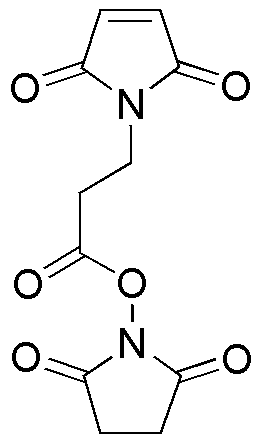3-Maleimidopropionic acid NHS is widely utilized in research focused on:
- Bioconjugation: This compound is essential for linking proteins, antibodies, or peptides to other molecules, enhancing drug delivery systems and diagnostics.
- Targeted Drug Delivery: It allows for the development of targeted therapies by attaching drugs to specific cells or tissues, improving treatment efficacy while minimizing side effects.
- Diagnostics: Used in the creation of biosensors and diagnostic kits, it helps in the detection of diseases by facilitating the attachment of biomolecules to surfaces.
- Research in Protein Engineering: This compound aids in the modification of proteins to study their functions and interactions, which is crucial in developing new therapeutic strategies.
- Vaccine Development: It plays a role in the formulation of vaccines by enabling the conjugation of antigens to carriers, enhancing immune response and stability.
General Information
Properties
Safety and Regulations
Applications
3-Maleimidopropionic acid NHS is widely utilized in research focused on:
- Bioconjugation: This compound is essential for linking proteins, antibodies, or peptides to other molecules, enhancing drug delivery systems and diagnostics.
- Targeted Drug Delivery: It allows for the development of targeted therapies by attaching drugs to specific cells or tissues, improving treatment efficacy while minimizing side effects.
- Diagnostics: Used in the creation of biosensors and diagnostic kits, it helps in the detection of diseases by facilitating the attachment of biomolecules to surfaces.
- Research in Protein Engineering: This compound aids in the modification of proteins to study their functions and interactions, which is crucial in developing new therapeutic strategies.
- Vaccine Development: It plays a role in the formulation of vaccines by enabling the conjugation of antigens to carriers, enhancing immune response and stability.
Documents
Safety Data Sheets (SDS)
The SDS provides comprehensive safety information on handling, storage, and disposal of the product.
Product Specification (PS)
The PS provides a comprehensive breakdown of the product’s properties, including chemical composition, physical state, purity, and storage requirements. It also details acceptable quality ranges and the product's intended applications.
Certificates of Analysis (COA)
Search for Certificates of Analysis (COA) by entering the products Lot Number. Lot and Batch Numbers can be found on a product’s label following the words ‘Lot’ or ‘Batch’.
Numéro de catalogue
Numéro de lot/série
Certificates Of Origin (COO)
This COO confirms the country where the product was manufactured, and also details the materials and components used in it and whether it is derived from natural, synthetic, or other specific sources. This certificate may be required for customs, trade, and regulatory compliance.
Numéro de catalogue
Numéro de lot/série
Safety Data Sheets (SDS)
The SDS provides comprehensive safety information on handling, storage, and disposal of the product.
DownloadProduct Specification (PS)
The PS provides a comprehensive breakdown of the product’s properties, including chemical composition, physical state, purity, and storage requirements. It also details acceptable quality ranges and the product's intended applications.
DownloadCertificates of Analysis (COA)
Search for Certificates of Analysis (COA) by entering the products Lot Number. Lot and Batch Numbers can be found on a product’s label following the words ‘Lot’ or ‘Batch’.
Numéro de catalogue
Numéro de lot/série
Certificates Of Origin (COO)
This COO confirms the country where the product was manufactured, and also details the materials and components used in it and whether it is derived from natural, synthetic, or other specific sources. This certificate may be required for customs, trade, and regulatory compliance.


